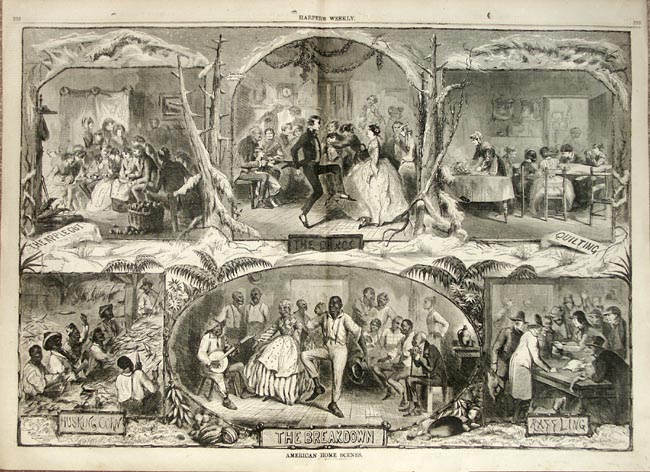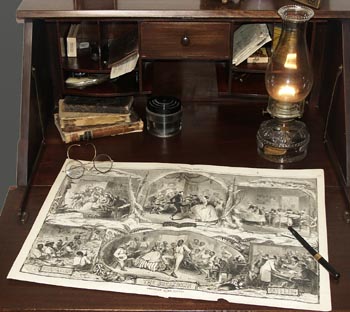
Description:
This leaf is an 1861 illustration by Thomas Nast, one of the most noted
artists of the 1800's. Nast is credited with creating the popular image
of Santa Clause, created the original democratic donkey image, and the
original republican elephant image. While famous for those images that
have become part of our popular culture, none of his work could be as
touching, captivating or collectible as this particular piece.
Remember, the piece was created at a time when slavery was still
practiced, and considered acceptable by many in this country. In this
particular illustration, Nast introduces what would have been a
revolutionary concept . . . that people are all basically the same, as
reflected by their family customs and traditions. He drives home this
point by showing traditional family activities of White's on the top,
and corresponding activities of Black or Slave families on the bottom.
For example, the upper left inset image shows a white family celebrating
an "apple cutting", which was a tradition of whites at the time to come
together to store the apple harvest for the winter. Under it is an
image of a slave family celebrating a "Corn Husking". An old black man
is shown playing the fiddle as his friends and family shuck corn. "Corn
Huskings" were times when slaves from surrounding plantations would come
together to celebrate bringing in the corn crop. It was a time of
celebration, festivity, renewing old acquaintances, and making new ones.
(please email me if you would like resources or references on this Slave
tradition. I would be happy to provide at no cost to anyone interested)
Similarly, the
illustration shows a comparison between the White tradition of having
"dances", and the Slave tradition of having "Breakdowns".
In this
historically important leaf, Nast was making what would have been an
explosive point for his time . . . that we are all basically the same.
It was a revolutionary and controversial point at the time, but a belief
whose time had come, and one that helped serve as the beginning of the
end of slavery in this country.
Provenance:
This leaf was carefully removed from an original 1861 edition of
Harper's Weekly, the most popular illustrated newspaper of the day.
During the Civil War, Libraries would subscribe to Harper's Weekly. At
the end of the year, they would "bind" the individual newspapers into
large volumes. Fine art and other illustrations like this one survived
until today in the archives of Libraries or Historical Foundations. In
the 1970's and 1980's, Libraries microfilmed many of the volumes, and
sold the original volumes, filled with priceless treasures like this
one, to the public. I was fortunate enough to buy a large collection of
these volumes when they became available. Now, I make individual
illustrations like the one above available to individual collectors,
Unlike newsprint of this century, these older, original pages do not
yellow and fall apart. The reason is that modern newspapers use an acid
based process. Remnant acid in the paper causes the paper to quickly
yellow and deteriorate. A different process was used in the mid-1800's
which yielded an exceptional quality paper that will last for
centuries. Special acid free mats should be used when you frame this
piece to ensure that it will last another 150 years. Acid free mats are
available at most better frame shops. If you have any questions related
to handling or framing this piece feel free to email me. The leaf is
approximately 16x21 inches.
Condition:
The leaf is in very good condition. It has the rich sepia tone that you
expect in original material from this period. It has some light spots of
foxing, consistent with its 140 years of age. There are several areas
of finger smudging in the margins from people handling the leaf over the
last 140 years. The piece is highly displayable, and I guarantee your
satisfaction!
This piece will
make a stunning display when framed and placed in your office or study.
It will become the center of attention, and I assure all who enter will
notice it.
Don't miss your
chance to acquire this truly unique piece of Black American History. It
would make the ultimate gift for any student of Black History. I assure
you that this leaf will become the prized procession of its new owner.
I ask you, what other purchase that you make this year will be cherished
by your children and their children a hundred years from now?
![]()
![]()

